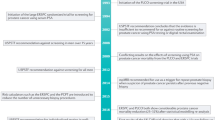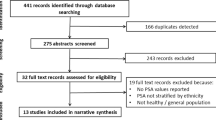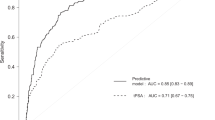Abstract
A questionnaire was sent to 400 general practitioners (GPs), concerning prostate-specific antigen (PSA) screening. Regarding the indications for PSA testing, 80% of GPs test men with urinary tract symptoms, 65% test men with a positive family history, 62% test on patient request, and 21% test men with unrelated symptoms. When PSA is measured, 91% of GPs inform their patient, and 71% discuss the significance of an abnormal result. The mean age range for PSA testing was from 50 years, without an upper age limit. The mode PSA threshold for referral was 6.6 ng/ml. De facto PSA screening appears to be widely practised.
This is a preview of subscription content, access via your institution
Access options
Subscribe to this journal
Receive 4 print issues and online access
$259.00 per year
only $64.75 per issue
Buy this article
- Purchase on Springer Link
- Instant access to full article PDF
Prices may be subject to local taxes which are calculated during checkout


Similar content being viewed by others
References
De Koning HJ et al. Large scale randomised prostate cancer screening trials: programme performances in the European Randomised Screening for Prostate Cancer trial and the prostate, lung and ovary cancer trial. Int J Cancer 2002; 97: 237–244.
Horninger W et al. Prostate cancer screening in the Tyrol, Austria: experience and results. Eur J Cancer 2000; 36: 1322–1335.
Crawford ED et al. Efficiency of prostate-specific antigen and digital rectal examination in screening, using 4.0 ng/ml and age-specific reference range as a cut-off for abnormal values. Prostate 1999; 38: 296–302.
Labrie F et al. Screening decreases prostate cancer death: first analysis of the 1988 Quebec prospective randomised controlled trial. Prostate 1999; 38: 83–91.
Perron L et al. PSA screening and prostate cancer mortality. Can Med J 2002; 166: 586–591.
Morris J, McNoe B, Adam H . Screening for prostate cancer: what do general practitioners think? N Z Med J 1997; 110: 178–182.
Bunting PS, Goel V, Williams I, Iscoe NA . Prostate specific antigen testing in Ontario: reasons for testing patients without diagnosed prostate cancer. Can Med J 1999; 160: 70–75.
McNaughton Collins M, Stafford RS, Barry MJ . Age-specific patterns of prostate-specific antigen testing among primary care physician visits. J Fam Pract 2000; 49: 169–172.
Luboldt HJ et al. The Early Detection Project Group of the German Urological Association Early detection of prostate cancer in Germany: a study using digital rectal examination and 4.0 ng/ml prostate-specific antigen as cut-off. Eur Urol 2001; 39: 131–137.
Gustafsson O et al. Prostate-specific antigen (PSA), PSA density and age-adjusted PSA reference values in screening for prostate cancer—a study of a randomly selected population of 2,400 men. Scand J Urol Nephr 1998; 32: 373–377.
Spitz MR et al. Familial patterns of prostate cancer: a case–control analysis. J Urol 1991; 146: 1305–1307.
Yao SL, Lu-Yao G . Interval after prostate specific antigen testing and subsequent risk of incurable prostate cancer. J Urol 2001; 166: 861–865.
Ito K et al. Correlation of prostate-specific antigen before prostate cancer detection and clinicopathologic features: evaluation of mass screening populations. Urology 2000; 55: 705–709.
Maattanen L et al. European randomised study of prostate cancer screening: first-year results of the Finnish trial. Br J Cancer 1999; 79: 1210–1214.
Kirby RS et al. Screening for carcinoma of the prostate: a GP based study. B J Urol 1994; 74: 64–71.
Oesterling JE, Jacobsen SJ, Cooner WH . The use of age specific reference ranges for serum prostate specific antigen in men 60 years old or older. J Urol 1995; 153: 1160–1163.
Ellis W et al. Serial prostate specific antigen, free to total prostate specific antigen ratio and complexed prostate specific antigen for the diagnosis of prostate cancer. J Urol 2001; 166: 93–99.
Nijs HG et al. Why do men refuse or attend population-based screening for prostate cancer. J Public Health Med 2000; 22: 312–316.
Author information
Authors and Affiliations
Corresponding author
Appendix : Full text of the PSA screening questionnnaire
Rights and permissions
About this article
Cite this article
Little, B., Ho, K., Gormley, G. et al. PSA testing in general practice. Prostate Cancer Prostatic Dis 6, 154–158 (2003). https://doi.org/10.1038/sj.pcan.4500646
Received:
Revised:
Accepted:
Published:
Issue Date:
DOI: https://doi.org/10.1038/sj.pcan.4500646
Keywords
This article is cited by
-
General practitioners’ approaches to prostate-specific antigen testing in the north-east of the Netherlands
BMC Family Practice (2020)
-
PSA-basierte Früherkennung des Prostatakarzinoms durch den Hausarzt
Der Urologe (2014)
-
Prostate specific antigen testing policy worldwide varies greatly and seems not to be in accordance with guidelines: a systematic review
BMC Family Practice (2012)
-
Bekkenfysiotherapie bij mictieproblematiek van vrouwen en mannen
Bijblijven (2011)
-
Huisartsen en patiënten denken bij plasklachten bij oudere mannen nog steeds aan prostaatcarcinoom
Huisarts en Wetenschap (2007)



